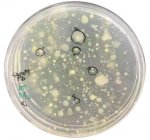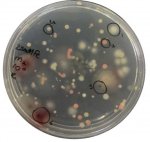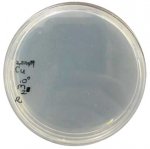I helped a bit on an interesting experiment. Although its on freshwater, bacteria is bacteria and the marine results should not differ much.
Cupamine is basically a copper dilution you add to your tank. To kill the whitespot in that little window of opportunity while looking for a host between hatching from a cyst and finding a target host. The copper level should be spot on, else its ineffective. Too strong and you poison your fish, too weak and the whitespot pests is not affected enough. Problem is that rock, sand and even silicone absorbs some of the copper and changes the copper level. And you must be sure that ALL got killed before finding a host. Actually finding a host in our little systems is not that difficult, although in the wild its not that easy, that's the reason why they hatch in such numbers, between 200 and 1000 per cyst.
Anyway, back to the experiment. We all know that lead is like poison when ingested. What does it do to bacteria in a weak lead solution. The stronger the solution, the less growth did show up.
Well, it seems that various bacterial colonies are actually growing. If striving? I cannot say, but there they are. Each different size dot is another species. Same as for the color variations and shapes. This plate got 5 species marked.
Just for the fun, Iron
Nice colors... Also 5 different species of bacteria marked.
Anyway, what about copper, on the same dilution?
NOTHING. NANA. Boggerol.
Bacteria could not grow on the same dilution ratio in a copper solution over same time period.
And we hope that this copper can destroy whitespot.
BUT
what about the beneficial bacteria colony we all depend on in our tanks to keep all things stable. All those bacteria in the liverock that we took like ages to mature? Our DSB that took over 3 months to kick in? The NP-pellets or Orca Cubes? All those bacteria we feed with Vodka / sugar dosing?
We already got a stuffed up tank that's infected with whitespot. Now we kill all out bacteria and affect ammonia, nitrate and phosphate levels making the environment even more stuffed up, even affecting the corals now.
DO NOT USE CUPRAMINE IN YOUR DISPLAY TANK!
If using a quarantine system, note that there is not a bacterial colony you can rely on to help out with nitrogen cycle. Do frequent water changes to keep the water in absolute excellent conditions. Have a copper test kit available to test and set the copper levels correctly after each water change.
Thread on the experiments
https://www.marineaquariumsa.com/th...r-heavy-metals-vs-bacteria.66509/#post-979927
Plus excellent question from
@tekkengal
I wonder how copper will affect the bacteria in a fish's gut when they are quarantined in a copper solution? Should they also then not need some sort of probiotic after a copper treatment?
Same as us humans that need bacteria based pills after some medicine. Interfloria after antibiotics?






